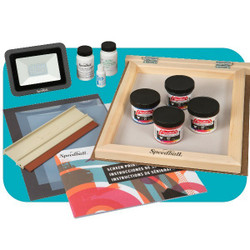
Screen Printing
Screen printing is a popular printing technique that involves pressing ink through a stencil (or "screen") onto a flat surface, such as fabric, paper, or plastic. This method is commonly used for printing on T-shirts, posters, signs, and other promotional materials.
Screen printing is a versatile process that can produce high-quality and durable prints in a range of colors and designs. The process begins with creating a stencil by coating a mesh screen with a light-sensitive emulsion and exposing it to a design or pattern. The areas that are exposed to light harden, while the unexposed areas remain soft and wash away when rinsed with water.
Once the stencil is ready, ink is applied to the screen and forced through the mesh and onto the substrate using a squeegee. Each color requires a separate stencil and pass through the screen, making screen printing a multi-step process that requires precision and attention to detail.
Screen printing can be done manually, using a small table or press, or with an automatic machine for larger quantities and complex designs. It is a popular printing method for producing custom apparel, promotional products, and art prints.
Overall, screen printing offers a versatile and cost-effective solution for producing high-quality and durable prints on a variety of surfaces.
There are no products listed under this category.
